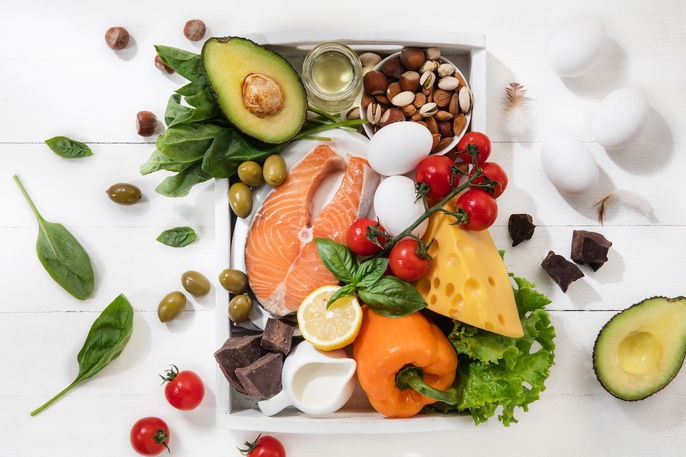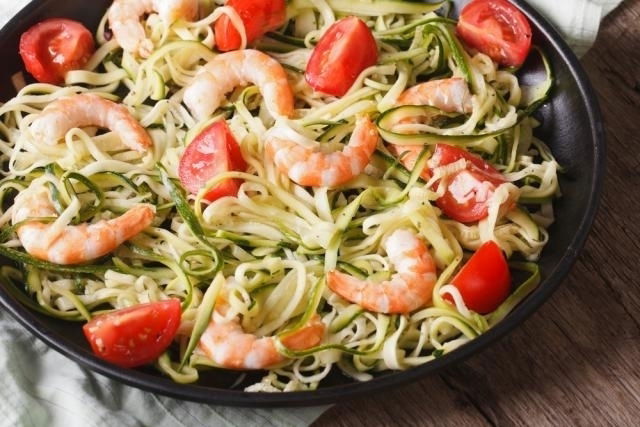What is it:
A low-carb diet involves reducing the consumption of foods that are high in carbohydrates, such as bread, pasta, sugary foods and white rice. Instead, this diet involves higher intake of protein and healthy fats like nuts, olive oil, and avocado.
This diet is a particularly attractive option for people looking to lose weight because it keeps you satiated and less hungry, while eating fewer calories.
Other than helping with weight loss, a low-carb diet is also free of processed foods and contains excellent amounts of antioxidants, vitamins, and minerals. It is beneficial for decreasing cholesterol, triglyceride and blood sugar levels levels, as well as preventing chronic illnesses such as cardiovascular disease, cancer, diabetes, or obesity.

Main health benefits
Following a low-carb diet can have several health benefits, such as:
- Controlling hunger, as increasing protein, fibers, and fat intake promotes satiety for longer periods;
- Reducing cholesterol and triglyceride levels, which reduces the risk of heart diseases;
- Managing diabetes, as this diet helps regulate blood sugar;
- Improving bowel function, as it's a diet rich in fiber;
- Encouraging weight loss, due to the reduction of total calories and increase of fiber in the diet;
- Fighting fluid retention, as it is a diet rich in water, and minerals such as potassium and magnesium, which increase the production of urine.
You should be monitored by a registered dietitian if you opt to start this diet, as the quantity and quality of carbohydrates may vary according to your individual needs and health status.
How to start a low-carb diet
To start a low-carb diet, you must remove as many simple carbohydrates from your diet as possible. This includes sugar, white flour, white pasta, white rice and most processed foods. Depending on the number of carbohydrates in your diet, you may also need to restrict complex carbohydrates, such as whole grain bread, oats or brown rice.
On average, a person will typically consume 250 grams of carbohydrates per day. In a low-carb diet however, carbs are restricted to 130 to 200 grams per day.
When the body is used to a daily portion of carbohydates, reducing amounts may result in some symptoms, like headaches, dizziness and mood swings. Therefore, low-carb diets should be gradually introduced to allow the body to adapt.
A low-carb diet should be outlined with 3 main meals and 2 snacks, as frequent meals with smaller portions are much more optimal. Breakfast and snacks should include eggs, cheese, nuts, avocado, or coconut. Lunch and dinner should be based on salads, protein, olive oil and only a small number of carbohydrates.
3-day low-carb meal plan
The following table gives you an example of a 3-day low-carb meal plan:
The amount of carbohydrates included in this meal plan may vary according to age, gender, physical activity level, and health history. It's recommended to get a complete assessment by a dietitian in order to outline a more suitable meal plan for your individual needs.
There is another type of low-carb diet, know as keto diet, where the amount of carbohydrates is even lower, ranging from 20 to 50 grams a day, which makes the body go into ketosis, hence the name. This is when the body starts using fat as the main source of energy, helping burn fat more quickly. However, this diet is only indicated in some cases and should be done under medical supervision. Learn more about the keto diet.
Foods Allowed
The foods that you can eat during a low carb diet include:
- Fresh fruits (preferably unpeeled and in small quantities), such as apple, pear, kiwi, plum, orange, tangerine or papaya;
- Vegetables (small portions), such as lettuce, arugula, tomato, spinach, broccoli, cauliflower;
- Lean proteins, especially chicken and turkey without the skin;
- Fish, preferably the fattier ones such as salmon, tuna, trout, or sardine;
- Milk and milk products, such as cheese and yogurts;
- Good fats, such as olive oil;
- Nuts, such as walnuts, almonds, Brazil nuts, and peanuts;
- Seeds in general, such as chia, flax, sunflower, pumpkin seeds, and sesame seeds;
- Water, sugar-free coffee and teas.
Milk can be substituted for vegetable-based drinks, such as coconut milk or almond milk.
Some foods have moderate amounts of carbohydrates, which may or may not be included by the dietitian in your low-carb diet plan. These include beans, lentils, wholegrain rice, sweet potato, yam, and pumpkin.
Foods You Should Avoid
When following a low-carb diet, it's important to avoid foods that are rich in carbohydrates, such as:
- Sugary foods: sodas, processed fruit juices, sweeteners, desserts;
- Grains: white rice, white pasta, cassava, couscous;
- Dried fruits: raisins, dried apricots, prunes;
- Flours: tapioca, white flour, and foods prepared with flour, such as pancakes, cakes, and cookies.
In addition to foods rich in carbohydrates, it's necessary to exclude most processed foods from your diet, since they tend to include higher amounts of hidden carbohydrates. It is also recommended to avoid having alcohol.
Amount of Carbs in Common Foods
The following table contains some common foods and the amount of carbohydrates for 100 g:
Healthy Low Carb Recipes
Here are some healthy and delicious recipes you can include in your low carb diet:
1. Zucchini noodles
100 grams contains about 59 calories, 1.1 g protein, 5 g fat, and 3 g carbohydrates.

Ingredients:
- 1 small zucchini sliced into small strips;
- 1 teaspoon of coconut oil or olive oil;
- Sea salt and ground pepper, to taste;
Preparation method:
Slice the zucchini lengthways in the shape of spaghetti (there are also some slicers/peelers that can cut vegetables in the shape of spaghetti). In a frying pan, heat the coconut oil (or olive oil) and add the zucchini. Fry for about 5 minutes until the zucchini softens. Season with salt, garlic, and pepper. Turn off the heat and serve with tomato sauce, meat and vegetables.
2. Spinach tortilla
A 80 gram portion provides approx. 107 calories, 4 g of protein, 9 g fat, and 2.5 g carbs.
Ingredients:
- 2 cups spinach or chard leaves;
- 4 egg whites lightly beaten;
- ½ sliced onion;
- 1 teaspoon of spring onion;
- Pinch of salt and pepper;
- 1 teaspoon of olive oil.
Preparation method:
Place the spinach leaves in a frying pan, cover, and keep on medium heat until they wilt (uncover and mix now and then). Then, remove from the heat and leave to rest for a few minutes on a plate.
In the same frying pan, place olive oil, onion, spring onions, salt, and pepper, and let the onion soften. Then add the egg whites and spinach, and leave to cook for another 5 minutes until the tortilla is golden on the bottom. Turn it and let it cook for another 5 minutes on the other side.
3. Stuffed cherry tomatoes
Four cherry tomatoes provides around 106 calories, 5 g of protein, 6 g of fat, and 5 g of carbohydrates.
Ingredients:
- 20 cherry tomatoes;
- 8 spoons (150 g) of ricotta cheese;
- 2 tablespoons of olive oil;
- 1 crushed garlic clove;
- Salt and pepper;
- 6 basil leaves (to serve).
Preparation method:
Wash the tomatoes and cut a small lid on the top, take the pulp out using a small spoon, but be careful not to prick the tomato. Fill the tomatoes with the ricotta cheese.
In a separate dish, mix the olive oil with garlic, salt, and pepper and place over the tomatoes. Serve with the basil leaves.
4. Sugar-free fruit jello
One portion of this jello contains approx. 16 calories, 1,4 g protein, 0 g fat, and 4 g of carbohydrates.
Ingredients (for 7 portions):
- ½ cup of sliced strawberries;
- ¼ chopped apple;
- ¼ chopped pear;
- 1 cup of boiling water;
- 1 sachet of strawberry jello (without sugar);
- ½ cup of cold water
Preparation method:
Place the jello mix in a pot and add hot water. Mix until it dissolves completely and then add cold water. At last, place fruit at the bottom of a dish and pour the diluted hello on top. Put it in the fridge and let it cool until it is formed
Who should not follow a low-carb diet
Women who are pregnant or breastfeeding, children and teenagers are not advised to follow a low-carb diet. Older adults and people with a history of kidney or liver problems should also not partake in this diet without seeking medical approval first.






























